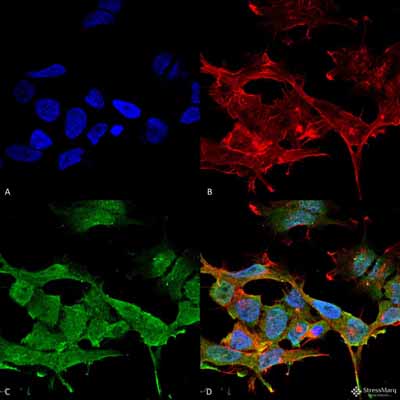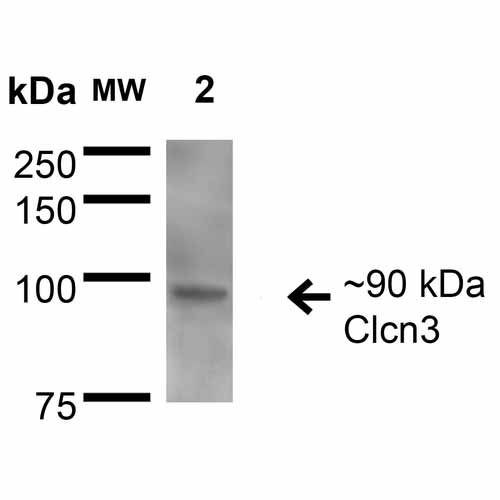Clcn3 Antibody
ClCN3 Antibody, Clone S258-5
- SPECIFICATION
- CITATIONS
- PROTOCOLS
- BACKGROUND

Application
| WB, IHC, ICC |
|---|---|
| Primary Accession | P51792 |
| Other Accession | NP_445815.2 |
| Host | Mouse |
| Isotype | IgG1 |
| Reactivity | Human, Mouse, Rat |
| Clonality | Monoclonal |
| Description | Mouse Anti-Rat Clcn3 Monoclonal IgG1 |
| Target/Specificity | Detects ~90kDa. Does not cross-react with Clcn4 or Clcn5 (based on KO validation results). |
| Other Names | CIC3 Antibody, CLC3 Antibody, CLCN 3 Antibody, Chloride channel 3 Antibody, Chloride channel protein 3 Antibody, Chloride channel Antibody, voltage-sensitive 3 Antibody, Chloride transporter ClC 3 Antibody, DKFZp564I0463 Antibody, H(+)/Cl(-) exchange transporter 3 Antibody, Chloride transporter ClC-3 Antibody, ClC-3 Antibody, H(+)/Cl(-) exchange transporter 3 Antibody |
| Clone Names | S258-5 |
| Immunogen | Synthetic peptide amino acids 98-115 (cytoplasmic N-terminus) of rat Clcn3 |
| Purification | Protein G Purified |
| Storage | -20ºC |
| Storage Buffer | PBS pH7.4, 50% glycerol, 0.09% sodium azide |
| Shipping Temperature | Blue Ice or 4ºC |
| Certificate of Analysis | 1 µg/ml of SMC-408 was sufficient for detection of Clcn3 in 20 µg of rat brain membrane lysate and assayed by colorimetric immunoblot analysis using goat anti-mouse IgG:HRP as the secondary antibody. |
| Cellular Localization | Membrane | Endosome | Endosome membrane | Cytoplasmic Vesicle | Secretory Vesicle Membrane |

Thousands of laboratories across the world have published research that depended on the performance of antibodies from Abcepta to advance their research. Check out links to articles that cite our products in major peer-reviewed journals, organized by research category.
info@abcepta.com, and receive a free "I Love Antibodies" mug.
Provided below are standard protocols that you may find useful for product applications.
Background
Clcn3 mediates the exchange of chloride ions against protons, and functions as an antiporter and contributes to the acidification of the endosome and synaptic vesicle lumen, and may thereby affect vesicle trafficking and exocytosis. It may play an important role in neuronal cell function through regulation of membrane excitability by protein kinase C. It could also help neuronal cells to establish short-term memory.
References
1. www.phosphosite.org/proteinAction.do?id=5088&showAllSites=true
If you have used an Abcepta product and would like to share how it has performed, please click on the "Submit Review" button and provide the requested information. Our staff will examine and post your review and contact you if needed.
If you have any additional inquiries please email technical services at tech@abcepta.com.













 Foundational characteristics of cancer include proliferation, angiogenesis, migration, evasion of apoptosis, and cellular immortality. Find key markers for these cellular processes and antibodies to detect them.
Foundational characteristics of cancer include proliferation, angiogenesis, migration, evasion of apoptosis, and cellular immortality. Find key markers for these cellular processes and antibodies to detect them. The SUMOplot™ Analysis Program predicts and scores sumoylation sites in your protein. SUMOylation is a post-translational modification involved in various cellular processes, such as nuclear-cytosolic transport, transcriptional regulation, apoptosis, protein stability, response to stress, and progression through the cell cycle.
The SUMOplot™ Analysis Program predicts and scores sumoylation sites in your protein. SUMOylation is a post-translational modification involved in various cellular processes, such as nuclear-cytosolic transport, transcriptional regulation, apoptosis, protein stability, response to stress, and progression through the cell cycle. The Autophagy Receptor Motif Plotter predicts and scores autophagy receptor binding sites in your protein. Identifying proteins connected to this pathway is critical to understanding the role of autophagy in physiological as well as pathological processes such as development, differentiation, neurodegenerative diseases, stress, infection, and cancer.
The Autophagy Receptor Motif Plotter predicts and scores autophagy receptor binding sites in your protein. Identifying proteins connected to this pathway is critical to understanding the role of autophagy in physiological as well as pathological processes such as development, differentiation, neurodegenerative diseases, stress, infection, and cancer.



